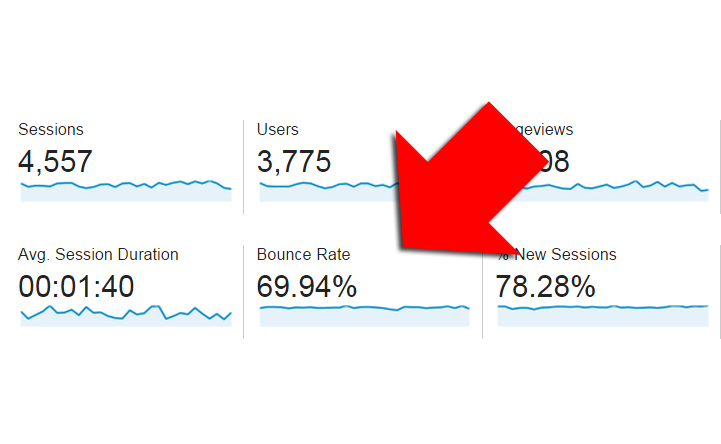Avoiding the Big Bounce: 7 Tips to Keep Your Website Bounce Rate in Check
A high bounce rate is often a conversion killer for most websites. However, just having a high bounce rate doesn’t mean your website is doing bad- a little bounce can mean you’re doing quite a few things right!
This may lead you to ask what a good bounce rate is. While the average bounce rate is 40%, you can’t go by this figure. That’s because a good bounce rate depends on the type of your website, the type of landing page, your brand credibility, the industry you’re catering to, the stage of the customer lifecycle, and other factors.

So if you’ve been trying to keep your bounce rate down to a particular figure assuming it’ll work for you like everyone else, you need to stop and take the time to distinguish the good bounce from the bad. Set a baseline that’s appropriate for your website and keep the bounce rate in check with these top tips!
Improve Speed
An improved load time is a confirmed ranking factor and lends to user experience, consequently reducing the bounce rate. According to surveys, users who have to wait for more than 10 seconds for a webpage to load are likely to bounce.

If your website loads in 7 seconds or less, you don’t have to worry about improving load speed. But if your website takes more than 10 seconds to load, reduce loading time by optimizing images, using a fast web host and a CDN (content distribution network), reducing redirects, and improving server response time.
Compressing a website with gzip also helps improve load speed, as does using caching or plugins. Just remember to switch off plugins or extensions you don’t need. In addition to this, avoid using self-loading multimedia content, and have external links open in new tabs or windows.
Have More Landing Pages
User expectations vary widely, so having a single landing page to address the needs of all users is bound to increase your website’s bounce rate. For example, if you are a local business, users outside your area of operation might contribute greatly to the bounce rate. In such a case, segmenting traffic can help avoid irrelevant visits to your website.
Additionally, having separate landing pages for mobile and desktop users, and new and regular users will also keep your website’s bounce rate in check.
Use the Right Keywords
Optimizing keyword usage is important if you want to direct the right kind of users to your site and thereby keep your website’s bounce rate under control. If you find that the bounce rate on specific pages is high, consider tweaking keywords- perhaps your users bounce off your site because they don’t find what the keywords promised.

Using the right keywords on your website pages also means that you’re not wasting money on keywords that don’t work for you.
Make the Content Readable
If the content on your website is too small or too compactly arranged, you’re sure to turn off your users. Having the content laid out so that it is readable will ensure your users don’t bounce away the minute the page loads.
Use a larger font so that users don’t have to squint to read text. Avoid using cursive fonts and split long passages into chunks to make reading easy. Use sub-headings, bullet points, and graphs where necessary. Bolden keywords where required but don’t overdo it!
Keep Your Website Interesting
Look closely at your website design and how you’ve worded the content. If the design is unattractive or if the content you’ve used is outdated, you won’t be able to hold a user’s interest for long.
Make your website look trustworthy and professional. Also evaluate page content regularly and see to it that it is well-written. Provide easy access to related content to get users to explore your website.
Furthermore, give your website a health check and make sure it works fine on all browsers and isn’t wrongly displayed at particular screen resolutions.
Have a Call-To-Action in Place
Once you’ve generated a user’s interest, it is time to get the user to act. A clear call-to-action that precisely describes what you’re selling is sure to grab eyeballs. Use verbs like ‘start’, ‘buy’, or ‘get’ to encourage users to take action. Provide obvious links to the next step if necessary.
Note that simply having a call-to-action button in place won’t help; you’ll have to place it in a way that it is visible to your users in seconds. If you’ve done everything right to generate a user’s interest, don’t let your efforts go waste by having a weak CTA.
Use Popups Wisely
A majority of users find popup ads to be annoying; do your users a favor and refrain from using them on your website. If you must use popups, make sure you’re not using aggressive or bullying language in your ads.
Also, make your popup ads as unobtrusive as possible to keep your users from going away.
Conclusion
A higher than average bounce rate isn’t always a bad thing, but if you’re trying to improve your website’s conversion rate, eliminating the bad bounce will definitely help!
With the tips given here, you now know what to do to give your website users a positive experience and reduce the bounce rate. So get started on doing the right things – care about the metrics, but don’t compare with other websites!
